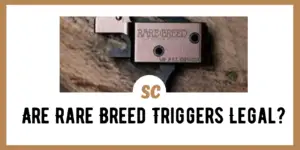Disclaimer
The information presented here is for discussion and educational purposes only. The author is not an attorney. The following does not constitute legal advice or legal counsel. The author is neither an employee of Rare Breed Triggers or the Rare Breed FRT 15 trigger, nor does he have any fiduciary interest in the company or its products.
Rare Breed FRT 15 Triggers
One of the hottest and most-talked about AR platform addons to hit the market in the past few years are the Rare Breed trigger assemblies manufactured by Rare Breed Triggers, an Orlando-based trigger manufacturer.
The innovative design of this trigger group allows a standard civilian legal AR platform rifle to fire almost as fast as a fully automatic machine gun.
The Rare Breed Trigger FRT-15 trigger group is a forced reset trigger mechanism. Forced reset triggers operate by causing the action of the bolt carrier group to trip the reset on the trigger automatically.
If you maintain pressure on the trigger after the shot is fired, the bolt will release the hammer on the forward stroke, allowing the trigger pull to initiate another shot immediately.
Rare Breed Triggers claims that the trigger design meets the letter of the law because the trigger does perform a full reset during the process. The trigger must be pulled by the shooter to fire another shot. The Bureau of Alcohol, Tobacco, Firearms and Explosives has made the determination that the action makes the rifle a controlled item under the National Firearms Act (NFA), therefore, they are considered machine guns and illegal to sell or own.
The Technicalities of Trigger Operation
The controversy stems from a combination of legal definitions, legal interpretations, and some fine details in how the Rare Breed trigger operates. To really understand, you must have a basic understanding of all the technical details and definitions that are in play in this issue.
The Standard AR Semi-Automatic Trigger
The semi-automatic trigger group in a civilian legal AR platform rifle consists of several parts that operate in a very specific manner. Typically, the standard AR trigger group, technically referred to as the fire control group has the following parts:
- Trigger
- Disconnector
- Sear
- Hook
- Hammer
The Cocking and Disconnect Cycle
In operation, each time the trigger is pulled, it releases the hammer by operating the hook. As soon as the round in the chamber is fired, the bolt carrier is forced back by gas from the barrel, which ejects the spent casing, cocks the hammer, and engages the hook. On the return cycle, the bolt carrier group places an unfired cartridge in the chamber.
The trigger group disconnect prevents the hammer from moving forward until the trigger is released and the disconnector engages, allowing the trigger pull to disengage the hook for a second shot.
The Rare Breed Trigger Difference
A Rare Breed Trigger group performs all of these functions. However, there is one striking difference in the steps that are performed during the firing sequence.
This is the cause of the controversy and where interpretations of the BATF rules and regulations lead to disputes about the legality of the Rare Breed Triggers FRT-15 trigger.
The Firing Cycle Using an FRT-15 Trigger
When you pull the trigger on an AR equipped with a Rare Breed FRT-15 trigger, the initial operations are just like any other trigger assembly: a trigger pull releases the hammer, which strikes the firing pin and fires the round in the chamber.
Gas comes back down the gas tube and forces the bolt carrier group backward. This ejects the spent cartridge from the rifle, cocks the hammer, and engages the trigger disconnect.
The Controversial Difference
The action performed by the rare breed trigger assembly occurs on the forward stroke of the bolt carrier group.
At this point, the bolt carrier groups strip a fresh cartridge from the top of the magazine and place it into the chamber. However, the rare breed trigger is forced forward to the reset point (also moving the shooter’s trigger finger forward as well).
If you maintain pressure on the trigger as the bolt moves forward, the trigger will release the hammer almost immediately as the bolt locks. This allows a second shot to be initiated, starting the whole process over. This allows very rapid fire rates in otherwise semi-automatic weapons.
A Matter of Interpretation – Reading the Rules
The whole controversy boils down to the way the BATF rules and regulations are read and interpreted.
To gain an understanding of the foundation of this legal challenge, you must have some understanding of the National Firearms Act (NFA) and the BATF stance on the Gun Control Act and how it addresses the term “machine gun.”
The Words in Question
The first part of the controversy and dispute stems from the definition of a firearm. The federal codes identify the legal definition of a firearm arm in the following words:
The term “firearm” means (A) any weapon (including a starter gun) which will or is designed to or may readily be converted to expel a projectile by the action of an explosive; (B) the frame or receiver of any such weapon; (C) any firearm muffler or firearm silencer; or (D) any destructive device. Such term does not include an antique firearm. The Gun Control Act of 1968 (GCA) 18 USC ss 921(a)(3)
The generally accepted interpretation of this piece of the federal code is that a firearm is something that propels a projectile and is powered by an explosive device such as a cartridge case filled with powder.
This raises a question about how just a trigger group can be considered a machine gun.
The Specifics of the National Firearms Act
The second bit of legalese that comes into play is the further definition of a “machine gun” from the National Firearms Act of 1934 (NFA). This piece of federal legislation read as follows:
The term “machine gun” means any weapon which shoots, is designed to shoot, or can be readily restored to shoot, automatically more than one shot, without manual reloading, by a single function of the trigger. The term shall also include the frame or receiver of any such weapon, any part designed and intended solely and exclusively, or combination of parts designed and intended, for use in converting a weapon into a machinegun, and any combination of parts from which a machinegun can be assembled if such parts are in the possession or under the control of a person. 26 USC ss 5845(b)
The key phrase in this passage is “designed to shoot, or can be readily restored to shoot, automatically more than one shot, without manual reloading, by a single function of the trigger.”
Rare Breed maintains that their trigger should not be considered machine guns because the trigger performs a full reset and must be pulled again to initiate another firing sequence. Technically, the trigger doesn’t fire repeatedly unless it is manually pulled to release the hammer.
The BATF Interpretation
The BATF doesn’t agree. Apparently, the simple fact that the Rare Breed triggers allow standard semi-automatic firearms to cycle almost as fast as a select fire weapon is enough to trigger their response.
It should be noted that the federal rules, regulations, and legislation do not, in any way, mention or refer to the rate of fire as a deciding factor on whether a firearm is a machine gun or not.
The Binary Triggers Question
Binary triggers, those triggers which allow a rifle to fire on the pull of the trigger and the forward motion of the trigger, don’t seem to fall into the same categorization of machine guns by the BATF. It has long been held that the cycle of a trigger, when the trigger moved backward and then the trigger forward movement of the reset, are two distinct cycles, and therefore a binary trigger fails to meet the criteria of a machine gun.
The Point of Contention – What Constitutes a Trigger Reset?
Even though it is clearly demonstrable that the Rare Breed FRT 15 triggers perform a full trigger reset during a firing cycle and cannot fire without this hard reset trigger being performed doesn’t seem to figure into the BATF decision. It would appear that the main concern of the BATF is that you cannot visually identify the point of trigger reset during a firing cycle purely by observation
The Rare Breed triggers first force a reset and lock, preventing the trigger from operating and releasing the hammer. The big difference is the locking bar is then disengaged, allowing the trigger to function normally.
This means that the shooter is prevented from pulling the trigger until the locking bar disengages at the end of the bolt cycle, which means another trigger pull is required to fire the next cartridge.
The Trigger Reset Versus No Reset Issue
In fully automatic weapons, there is no reset between each successive round being fired. As long as you hold the trigger back, the gun will continue to cycle until the magazine is empty. The cycle only stops when the trigger is released forward, and the trigger hook re-engages the hammer.
Rare Breed triggers perform a trigger reset during each bolt carrier group cycle. This is easily demonstrated manually on these triggers.
However, the appearance is that the gun continues to fire without the shooter ever manually re-pulling the trigger. That seems to be the whole foundation of the BATF argument. The BATF simply can’t watch and see a trigger pull. Consequently, the deduction is that this constitutes a machine gun and the ATF’s position.
The Historical Legal Trail
ATF agents delivered a cease and desist letter to Rare Breed Triggers in July 2021. The ATF’s cease and desist letter claimed that the Rare Breed FRT trigger was, in fact:
A collection or combination of parts designed and intended to convert a semi-automatic weapon into a machine gun.
This is despite the fact that each cycle of the bolt on a gun with an installed FRT-15 trigger group forces a complete reset on the trigger that requires the trigger to be pulled to initiate another firing cycle.
The fact that the design of the FRT trigger allows the shooter to maintain pressure on the trigger is immaterial if you read the rules and regulations as they are written.
The Rare Breed Response
Rare Breed Triggers refused to ignore the cease and desist order from BATF and continued to manufacture and sell the FRT-15 triggers. The company’s response came swiftly.
Rare Breed Filed suit against the BATF in federal court, seeking a temporary restraining order against the BATF. The temporary restraining order was subsequently denied in August 2021. However, the lawsuit alleges that the BATF violated Rare Breed’s due process rights.
The legal battle is not over and may resume at any time. A lot depends on the political climate in Washington, DC and how the new Supreme Court interprets Federal law and how federal rules and regulations are created and enforced.
The BATF Counter Moves
In March of 2022, the BATF sent a letter to all Federal Firearms License Holders informing them of the BATF stance on forced reset triggers. By anyone’s reading, the letter is vague and almost impossible to interpret in any logical manner.
There is no mention of Rare Breed FRT-15 triggers specifically. Only inconclusive references to “some force reset triggers” being machine guns.
The letter further advises anyone in possession of a forced reset trigger to get advice by contacting the local ATF field Office for interpretation of the trigger and federal law.
Where the Lawsuit Stands Today
As of the date I write this article, the lawsuit filed by Rare Breed Triggers has been dismissed because the Judge in the federal court holding the case found that Rare Breed FRT 15 Triggers had not suffered any damages due to the BATF actions, and thus had no standing to bring their lawsuit.
The suit was dismissed without prejudice which means that plaintiff, Rare Breed Triggers, can re-initiate the lawsuit when and if the company suffers some irreparable harm from the BATF. It appears that everything is on hold for now.
What Does This Mean for People Who Bought A Rare Breed FRT 15 Trigger?
At this point, no one is really sure what this is all going to mean for the current owners of Rare Breed FRT 15 Triggers.
Historically, we can make some assumptions based on what has happened in the past when the BATF arbitrarily decides something doesn’t meet their definitions. Take, for instance, bump fire stocks.
The Bump Fire Stock Issue
A bump stock is a special butt stock assembly that, in essence, allows an AR to ride back and forth due to recoil while the trigger finger is held in a stationary position. Each forward and backward movement of the rifle due to recoil causes the trigger to impact against the stationary trigger finger, causing another firing cycle.
On the surface, this seems perfectly legal. Each shot requires the trigger to be pulled, and the gun will not fire more than one shot if the trigger is pulled and held continually.
Only one shot will fire. But, due to political pressure, the BATF deemed bump stocks to be “A collection or combination of parts designed and intended to convert a semi-automatic weapon into a machine gun.” Never mind that the trigger still had to be pulled for every shot.
The rules promulgated by the BATF about bump stocks made it illegal to manufacture, sell, transfer, or own a bump stock.
The stocks were to be destroyed or surrendered to the BATF on short notice or face very stiff federal charges. Even some of the most liberal legal minds in the country found fault with both the methods and the interpretation of the BATF in this instance.
Many pundits took the position that the BATF ignored the wording of the statutes that they cited as their authority, re-interpreted entire parts of the statute, and were creating laws outside of the legislative process. This debate continues to rage to this day.
Revisiting the Bump Stock Scenario
The whole issue of forced reset triggers smacks of the bump stock situation.
On the surface, based on reading the current laws and statutes, it seems perfectly legal. But when deemed to be illegal, puts many gun owners in a precarious legal situation. In fact, several retailers were visited by ATF agents, inventory was confiscated, and company records were seized.
However, I can find no concrete evidence that the ATF ever visited anyone’s home to search for a bump stock.
It seems that ATF is following the same scenario in regard to forced reset triggers. To date, I can find no evidence that the ATF has done more than issue an official ATF letter concerning their position on forced reset triggers and ATF regulations.
Some only-firearms retailers are still selling their limited inventories of FRT triggers, and Rare Breed’s website occasionally still shows the triggers being manufactured and for sale.
Can You Expect a Visit from ATF agents if you Bought a Rare Breed FRT 15 Trigger?
In my opinion, that is highly unlikely. If the ATF follows the usual pattern, they will do a lot of media making sure everyone is aware of their position and interpretation of the firearms laws and Rare Breed Triggers.
However, if you get caught with a Rare Breed FRT 15 Trigger installed on an AR rifle, you could be in serious trouble. In some instances, this type of violation serves as a stacking charge to go with other charges making the case against you even more serious and harder to defend.
It is true that the ATF works hard at controlling machine guns in civilian hands.
The Legality of Machine Guns
Contrary to popular belief, it is not illegal nor impossible for a civilian shooter to legally own a machine gun in the United States. There are provisions in the National Firearms Act, the Gun Control Act, and the Firearm Owners Protection Act that stipulate the requirements for privately owning a machine gun.
None of these legislative acts mentions forced reset trigger groups.
Owning machine guns in the U.S. is difficult, to say the least. It is also almost prohibitively expensive.
The ATF controls the issuance of the legal documents and required tax stamps to purchase and own a machine gun. Very few firearm retailers have the needed license to handle these transactions and don’t want the hassles associated with this heavily restricted part of the gun market.
My Feelings and Responses
Personally, I believe the BATF has gone way past its authority as a government agency in this matter.
No one but Congress has the authority to enact federal law, but many of the rules and regulations that the BATF uses are created without any legislative action. I also believe that political agendas drive many of these actions.
This is not a legal opinion by any stretch, but it is the personal opinion of a patriotic gun-owning American.
I must admit in closing that as of this minute, you probably should conclude that, in the eyes of the BATF and many others, Rare Breed Triggers are not legal to own. This is in spite of the fact that Rare Breed continues to manufacture and sell the FRT-15 triggers.
With this in mind, you must make up your own mind about purchasing one of these trigger groups.













![Survival Medicine Podcast: Hypothermia, Off-Grid Nursing, Pt. 1 [PODCAST] Survival Medicine Podcast: Hypothermia, Off-Grid Nursing, Pt. 1 [PODCAST]](https://survivalcove.com/wp-content/uploads/2021/11/survival-medicine-podcast-banner-370x297.jpg)





















